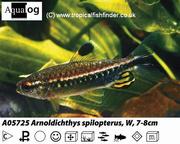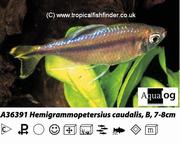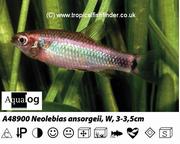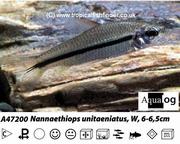Article categories:
Select a category below to view articles on each subject.
Search
Enter your keyword/s below to search :

Fish delivered straight to your door from Wildwoods
Hundreds of Species available today…
TFF Mailing List
Join the TFF mailing list today and we will email you with latest offers, news items and more.
Distichodus, Congo Tetras and other African Characins
Although aquarists usually associate characins with South America, the geographical range of the order Characiformes is much wider than that, including Central America and Africa as well. Central American characins are not routinely traded -- the blind cave-dwelling form of Astyanax mexicanus being the notable exception -- but African characins are diverse and increasingly widely traded. A few are staples of the hobby, in particular the Congo tetra Phenacogrammus interruptus and the nurse tetra Brycinus nurse.
African characins are usually hardy and adaptable. Most come from rainforest streams and rivers, often in places where the water is fast-flowing and well oxygenated. Consequently they do not like stagnant or excessively warm conditions, most doing best in well-filtered tanks maintained at 24-26 degrees C. Many species are tolerant of a broad range of water chemistry conditions, and can be expected to thrive between pH 6-8, 5-20 degrees dH. Softer, more acidic conditions will be required for breeding purposes though.
African characin diversity
One of the most striking things about the characins of Africa is their broad ecological diversity. While many are small, schooling fish that feed on small invertebrates, others are herbivorous, and some are enormous predators that sit at the top of the food chain. An example of the latter is the tiger characin Hydrocynus goliath, a schooling predator that measures up to 125 cm in length and weighs over 50 kg. Adult tiger characins have few natural enemies, though fishermen rate them as strong fighters and excellent sport fish.
The fin biters
Some of the most specialised characins can be found in the genera Belonophago, Ichthyborus, Paraphago, and Phago, commonly referred to as ‘fin parasites’. Besides consuming invertebrate prey and small fish, these fish bite the fins from any larger fish that swim by, using their powerful, scissor-like jaws to slice away fin tissue before darting away into the aquatic undergrowth. Occasionally these fin parasites are offered as aquarium fish, though for obvious reasons they are normally kept as single specimens in their own quarters. They are not especially hard to maintain, and readily take live foods such as midge larvae and earthworms.
Congo tetras and their relatives
The Congo tetra Phenacogrammus interruptus is the African characin most widely traded. It is of medium size and exhibits strong sexual dimorphism. Males are up to 8 cm in length and have very long, flamboyant fins; females are a bit smaller and their fins aren’t nearly so well developed. Both sexes are covered with large, iridescent scales that shimmer violet, blue or yellow depending on the light.
Congo tetras should be kept in groups of six or more specimens, with equal numbers of males and females in the group to avoid problems with bullying. Otherwise they are remarkably easy to care for, the only real problem being that they are prime targets for fin-nipping species such as serpae tetras (Hyphessobrycon spp.), black widow tetras (Gymnocorymbus ternetzi) and tiger barbs (Puntius pentazona). Congo tetras look best in planted tanks, where variations in light and shade really bring out their iridescent colours at their best. Although not essential, the addition of blackwater extract or the use of peat filtration darkens the water, making the colours of these fish even more dramatic. Avoid very hard water conditions: aim for pH 6.0-7.5, 5-15 degrees dH.
A related species known as the Yellow-tail Congo Tetra (Alestopetersius caudalis) has started to become more widely traded in recent years. It has a iridescent blue body and long fins marked with white. As its common name suggests, caudal fin is yellow but with a black band at the centre. Basic care is similar to the Congo tetra, though this species is a bit more boisterous and may nip the fins of slow moving tankmates.
The genus Brycinus
Over the years various Brycinus species have been traded as aquarium fish. The nurse tetra Brycinus nurse has been kept by fishkeepers since at least the early twentieth century, and remains a popular species thanks to its hardiness, peaceful nature, and attractive colours. Mature fish are shiny silver, with gold and black patches on the caudal peduncle, the gold patch on the caudal peduncle being matched with a gold patch on the top half of the eye. Maximum size in the wild is 25 cm, though aquarium specimens tend to be much smaller.
Nurse tetras should be kept in groups of six or more specimens. Given sufficient swimming space to feel comfortable they make excellent dither fish for use alongside cichlids, catfish, loaches and bichirs. They are very opportunistic feeders that will thrive on most flake, pellet and frozen foods. Very small fish may be consumed, but they are otherwise peaceful. Water chemistry is of little importance, these fish doing well between pH 6-8, 5-30 degrees dH.
The African long-finned tetra Brycinus longipinnis is another popular member of the genus. It is smaller than the nurse tetra, only getting to about 12 cm in length, though it still needs to be kept in a reasonably large aquarium. Mature fish are silvery with green-gold on the dorsal surface and a bold black patch on the caudal peduncle. Males have longer and more colourful fins than the females. A school of African long-finned tetras looks particularly good in a shady, well-maintained aquarium. Basic care is similar to that of the nurse tetra, and the African long-finned tetra can be relied upon to adapt to most water conditions.
African red-eye tetra
Another old favourite among the African tetras is the red-eye tetra Arnoldichthys spilopterus. It can appear a bit fearsome thanks to its large jaws and prominent teeth, but in fact the red-eye tetra is rather peaceful and makes an excellent community tank resident.
Like the Congo tetra this fish is covered with large, iridescent scales. Basic colouration is silvery-green, but with two bands running along the midline of the flank, one orange-gold, the other greenish-blue. The upper half of the eye is red, and there are prominent black and white patches on the dorsal fin. Maximum size is about 8 cm. Sexual dimorphism isn’t strong, being limited to differences in the shape of the trailing edge of the anal fin: on males the edge of the fin is convex, and on females it is straight. Males also sport patches of yellow on the anal fin, unlike the essentially uncoloured anal fins seen on females.
A typical schooling fish, the African red-eye tetra should be kept in groups of six or more specimens. Water chemistry is not critical, though similar water conditions to those suggested for Congo tetras would be ideal. It is a notorious jumper, so keep the tank securely covered!
African glowlight tetra
Unlike the African tetras mentioned so far the African glowlight tetra Nannaethiops unitaeniatus is a member of the family Citharinidae rather than Alestidae. Many citharines are herbivores, but the African glowlight is not, and in fact does best in planted tanks where it can stay close to thickets of vegetation. Under the right conditions this fish is very attractive, adopting a coppery colouration marked with a black line that runs from snout to tail. Its common name comes from a metallic orange stripe above this black line.
Maximum size is around 6 cm, but because this fish is shy and easily alarmed it shouldn’t be kept with substantially larger tankmates, and in fact does best combined with other small fish, such as Corydoras or small South American tetras. It is otherwise easy to maintain in tanks where the water is not too hard or basic (pH 6-7.5, 5-15 degrees dH).
Other small citharines are only very rarely seen in aquarium shops, or aquarium shops anywhere else for that matter. The killifish-like species Neolebias ansorgii for example is often discussed in aquarium books, being small (3.5 cm) and brilliantly coloured, the males having bright red bellies and blue-green bands along the flanks. But this species is timid and requires very soft, acidic conditions to do well (around pH 6, 5 degrees dH), and consequently has made little impact in the hobby.
Distichodus spp.
Quite different citharines are to be found in the genus Distichodus. Most species are quite big, typically 20-30 cm long, and they all have rather a boisterous personality whatever their size. The bigger species at least are best suited to rough-and-tumble communities alongside non-predatory cichlids, catfish, barbs, loaches, etc.
Some species are exceptionally colourful and have become regularly, if expensively, traded in as oddball additions for big community tanks. They are all herbivores, and cannot be kept in planted tanks: even things like Java ferns and Anubias are likely to be damaged, if not completely destroyed! Needless to say their diet should contain a lot of green material as well as the usual flakes and pellets. Useful foods include blanched lettuce, sushi nori, tinned peas, algae wafers, and aquatic plants such as Elodea and even duckweed (Lemna spp). None of the Distichodus species are fussy about water chemistry, though some effort will need to be made to ensure water quality remains good despite their messy feeding habits.
The most popular species is the six-banded distichodus Distichodus sexfasciatus. It looks more like a clown loach than a characin, having a chunky build, a very high back, red fins, and bold green-black stripes set against a bright orange body. As it ages the body colour fades a bit, tending towards orangey-yellow, but so it remains a strikingly attractive fish that understandably commands premium prices. In terms of social behaviour it is absolutely typical for the genus: gregarious but feisty, with individuals expending much energy jostling for position in the pecking order though rarely doing any actual harm. The six-banded distichodus is sometimes kept as a singleton but does best kept in groups of at least five specimens. Given that its maximum size is between 30-40 cm under aquarium conditions, this obviously means a big tank! Singletons do tolerably well and can become quite tame, provided they are not kept with overly aggressive tankmates.
The other species regularly traded is the red-fin distichodus, Distichodus affinis. This species is smaller than the six-banded distichodus, only getting to around 15 cm in length, but is otherwise very similar in terms of care. It has a silver-green body and, as its name would imply, has bright red fins.
Close: African and South American tetras compared
In broad terms, African tetras are larger and more active than the most commonly traded South American tetras. As such, they’re well suited to big community tanks with lots of swimming space. African tetras also tend to be less fussy about water chemistry, and in general have proven to be hardy and easily maintained. Most African tetras are peaceful and get along well with fish of similar size and temperament.
By contrast the South American tetras are celebrated for their small size and bright colours. Many species breed readily in captivity, and species such as neons and x-ray tetras are widely traded and comparatively inexpensive. On the downside, fin-nipping is more of a problem among South American tetras (notably among some Hyphessobrycon and Gymnocorymbus spp.) so a bit of care needs to be taken when choosing tankmates.
Other fish articles:
Other fish articles you may be interested in are listed below, click an article for full details.
-
FISH ARTICLE
-
FISH ARTICLE
-
FISH ARTICLE
-
FISH ARTICLE







.jpg)
.jpg)
.jpg)
(2).jpg)
.jpg)



